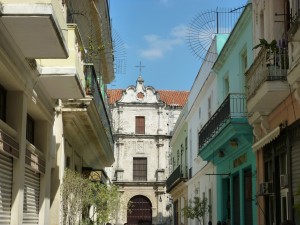By Joy Mulhollan
Neon orange, green, yellow, hot pink. Not the colors of fruity cereal or a fever dream, but what Communism looks like.
Coming back from Cuba, after making sure I didn’t get thrown in jail or contract some rare disease, because that’s what happens to everyone who survives travel to such a foreign, dangerous land (eye roll), the first thing that people ask is, “What was it like?” And of course no one actually wants to know what it was really like, so I usually respond, “It was great, really interesting.” And it was, but it was also more, and at the same time, less, than that.
One of the main things that has stuck with me even a few weeks after touching down again in as they say, North America, is the Cuban straws. This isn’t a euphemism for cigars or anything else; I mean the actual straws that are served with mojitos soda or bottled water. The reason is that they’re all the same. I expected one brand of ice cream or one type of third grade uniform for every third grader in the country, but seeing the same wild straws in every restaurant, whether state-run or privately owned paladar, shocked me in a way that I did not expect.
Fancy straws, as they came to be known in our group (I preferred the pink ones), were not only ubiquitous, they represented something greater. They were the nationalization of private enterprise that occurred in the 1960s, the bright-façaded, crumbling buildings, and the young student diplomats-in-training we met with, who were all very clearly different from each other, yet all conveyed the same shiny, propagandist message.
Don’t get me wrong, the fancy straws were great. Their five neon colors meant that the straws were always ready for a party, and plus they were the bendy kind, too, making drinking out of a straw even that much easier. All in all it was obvious that a lot of R&D went into the design of these perfect straws, but at the same time, what if I wanted a clear straw, or a black one? Those weren’t available, because in a command economy there is no competition. There is one kind of cola, one kind of tour company, one brand of toilet paper. And if you don’t like the strawberry ice cream? Get vanilla or do without.
That is what the straws taught me. They were great, really interesting, but at times maybe a little bit less than that.



